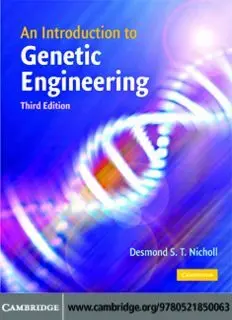Table Of ContentThis page intentionally left blank
An Introduction to Genetic Engineering
Third Edition
In this third edition of his popular undergraduate-level textbook,
DesmondNichollrecognisesthatasoundgraspofbasicprinciplesisvital
in any introduction to genetic engineering. Therefore, as well as being
thoroughly updated, the book also retains its focus on the fundamental
principles used in gene manipulation. The text is divided into three
sections: Part I provides an introduction to the relevant basic molecular
biology;PartII,themethodsusedtomanipulategenes;andPartIII,appli-
cations of the technology. There is a new chapter devoted to the emerg-
ingimportanceofbioinformaticsasadistinctdiscipline.Otheradditional
features include text boxes, which highlight important aspects of topics
discussed,andchaptersummaries,whichincludeaimsandlearningout-
comes.These,alongwithkeywordlistings,conceptmaps,andaglossary,
willenablestudentstotailortheirstudiestosuittheirownlearningstyles
andultimatelygainafirmgrasponthissubjectthatstudentstraditionally
finddifficult.
Desmond S. T. Nicholl is a Senior Lecturer in Biological Sciences at the
UniversityoftheWestofScotland,Paisley,UK.
An Introduction to
Genetic Engineering
Third Edition
Desmond S. T. Nicholl
University of the West of Scotland, Paisley, UK
CAMBRIDGEUNIVERSITY PRESS
Cambridge, New York, Melbourne, Madrid, Cape Town, Singapore, São Paulo
Cambridge University Press
The Edinburgh Building, Cambridge CB2 8RU, UK
Published in the United States of America by Cambridge University Press, New York
www.cambridge.org
Information on this title: www.cambridge.org/9780521850063
© Desmond S. T. Nicholl 2008
This publication is in copyright. Subject to statutory exception and to the provision of
relevant collective licensing agreements, no reproduction of any part may take place
without the written permission of Cambridge University Press.
First published in print format 2008
ISBN-13 978-0-511-39858-2 eBook (EBL)
ISBN-13 978-0-521-85006-3 hardback
ISBN-13 978-0-521-61521-1 paperback
Cambridge University Press has no responsibility for the persistence or accuracy of urls
for external or third-party internet websites referred to in this publication, and does not
guarantee that any content on such websites is, or will remain, accurate or appropriate.
Contents
Preface to the third edition pagexi
Chapter 1 Introduction 2
Chapter summary 2
1.1 What is genetic engineering? 3
1.2 Laying the foundations 5
1.3 First steps 6
1.4 What’s in store? 7
Concept map 10
Part I The basis of genetic engineering
Chapter 2 Introducing molecular biology 12
Chapter summary 12
2.1 The way that living systems are organised 13
2.2 The flow of genetic information 15
2.3 The structure of DNA and RNA 16
2.4 Gene organisation 19
2.4.1 Theanatomyofagene 20
2.4.2 Genestructureinprokaryotes 21
2.4.3 Genestructureineukaryotes 22
2.5 Gene expression 23
2.5.1 Fromgenestoproteins 24
2.5.2 Transcriptionandtranslation 24
2.5.3 Regulationofgeneexpression 25
2.6 Genes and genomes 27
2.6.1 Genomesizeandcomplexity 28
2.6.2 Genomeorganisation 29
2.6.3 Thetranscriptomeandproteome 30
Concept map 31
Chapter 3 Working with nucleic acids 32
Chapter summary 32
3.1 Laboratory requirements 33
3.2 Isolation of DNA and RNA 34
3.3 Handling and quantification of nucleic acids 35
3.4 Labelling nucleic acids 37
3.4.1 Typesoflabel--radioactiveornot? 37
3.4.2 Endlabelling 38
3.4.3 Nicktranslation 38
3.4.4 Labellingbyprimerextension 39
3.5 Nucleic acid hybridisation 39
vi
3.6 Gel electrophoresis 40
3.7 DNA sequencing 41
3.7.1 PrinciplesofDNAsequencing 42
3.7.2 PreparationofDNAfragments 43
3.7.3 Maxam--Gilbert(chemical)sequencing 44
3.7.4 Sanger--Coulson(dideoxyorenzymatic)sequencing 45
3.7.5 Electrophoresisandreadingofsequences 47
3.7.6 AutomationofDNAsequencing 48
Concept map 49
Chapter 4 The tools of the trade 50
Chapter summary 50
4.1 Restriction enzymes -- cutting DNA 51
4.1.1 TypeIIrestrictionendonucleases 52
4.1.2 Useofrestrictionendonucleases 53
4.1.3 Restrictionmapping 55
4.2 DNA modifying enzymes 55
4.2.1 Nucleases 56
4.2.2 Polymerases 57
4.2.3 EnzymesthatmodifytheendsofDNAmolecules 58
4.3 DNA ligase -- joining DNA molecules 58
Concept map 60
Part II The methodology of gene manipulation
Chapter 5 Host cells and vectors 62
Chapter summary 62
5.1 Host cell types 64
5.1.1 Prokaryotichosts 64
5.1.2 Eukaryotichosts 65
5.2 Plasmid vectors for use in E. coli 66
5.2.1 Whatareplasmids? 66
5.2.2 Basiccloningplasmids 67
5.2.3 Slightlymoreexoticplasmidvectors 69
5.3 Bacteriophage vectors for use in E. coli 70
5.3.1 Whatarebacteriophages? 71
5.3.2 Vectorsbasedonbacteriophage(cid:1) 75
5.3.3 VectorsbasedonbacteriophageM13 78
5.4 Other vectors 79
5.4.1 Hybridplasmid/phagevectors 80
5.4.2 Vectorsforuseineukaryoticcells 80
5.4.3 Artificialchromosomes 83
5.5 Getting DNA into cells 84
5.5.1 Transformationandtransfection 84
5.5.2 PackagingphageDNAinvitro 85
5.5.3 AlternativeDNAdeliverymethods 86
Concept map 89
vii
Chapter 6 Cloning strategies 90
Chapter summary 90
6.1 Which approach is best? 91
6.2 Cloning from mRNA 93
6.2.1 SynthesisofcDNA 94
6.2.2 CloningcDNAinplasmidvectors 97
6.2.3 CloningcDNAinbacteriophagevectors 99
6.3 Cloning from genomic DNA 101
6.3.1 Genomiclibraries 102
6.3.2 PreparationofDNAfragmentsforcloning 104
6.3.3 Ligation,packaging,andamplificationoflibraries 105
6.4 Advanced cloning strategies 108
6.4.1 SynthesisandcloningofcDNA 108
6.4.2 ExpressionofclonedDNAmolecules 110
6.4.3 CloninglargeDNAfragmentsinBACandYACvectors 113
Concept map 115
Chapter 7 The polymerase chain reaction 116
Chapter summary 116
7.1 History of the PCR 117
7.2 The methodology of the PCR 120
7.2.1 TheessentialfeaturesofthePCR 120
7.2.2 ThedesignofprimersforPCR 122
7.2.3 DNApolymerasesforPCR 124
7.3 More exotic PCR techniques 125
7.3.1 PCRusingmRNAtemplates 125
7.3.2 NestedPCR 126
7.3.3 InversePCR 127
7.3.4 RAPDandseveralotheracronyms 127
7.4 Processing of PCR products 128
7.5 Applications of the PCR 130
Concept map 131
Chapter 8 Selection, screening, and analysis of
recombinants 132
Chapter summary 132
8.1 Genetic selection and screening methods 134
8.1.1 Theuseofchromogenicsubstrates 134
8.1.2 Insertionalinactivation 135
8.1.3 Complementationofdefinedmutations 137
8.1.4 Othergeneticselectionmethods 137
8.2 Screening using nucleic acid hybridisation 138
8.2.1 Nucleicacidprobes 138
8.2.2 Screeningclonebanks 140
8.3 Use of the PCR in screening protocols 142
8.4 Immunological screening for expressed genes 144
viii
8.5 Analysis of cloned genes 144
8.5.1 CharacterisationbasedonmRNAtranslationinvitro 144
8.5.2 Restrictionmapping 146
8.5.3 Blottingtechniques 147
8.5.4 DNAsequencing 149
Concept map 151
Chapter 9 Bioinformatics 152
Chapter summary 152
9.1 What is bioinformatics? 153
9.2 The role of the computer 154
9.3 Biological data sets 156
9.3.1 Generationandorganisationofinformation 157
9.3.2 Nucleicaciddatabases 157
9.3.3 Proteindatabases 160
9.4 Using bioinformatics as a tool 161
9.4.1 TheimpactoftheInternetandtheWorldWideWeb 162
9.4.2 Avoidingthe‘GIGO’effect--realexperiments 163
9.4.3 Avoidingthetesttube--computationalexperimentation 164
9.4.4 Presentationofdatabaseinformation 164
Concept map 167
Part III Genetic engineering in action
Chapter 10 Understanding genes, genomes,
and ‘otheromes’ 170
Chapter summary 170
10.1 Analysis of gene structure and function 171
10.1.1 Acloserlookatsequences 172
10.1.2 Findingimportantregionsofgenes 172
10.1.3 Investigatinggeneexpression 174
10.2 From genes to genomes 175
10.2.1 Geneexpressioninagenomecontext 176
10.2.2 Analysinggenomes 178
10.2.3 Mappinggenomes 180
10.3 Genome sequencing 181
10.3.1 Sequencingtechnology 182
10.3.2 Genomeprojects 183
10.4 The Human Genome Project 186
10.4.1 Whosegenome,andhowmanygenesdoesitcontain? 188
10.4.2 Geneticandphysicalmapsofthehumangenome 188
10.4.3 Derivingandassemblingthesequence 190
10.4.4 Presentationandinterrogationofthesequence 192
10.5 ‘Otheromes’ 193
10.5.1 Thetranscriptome 194
10.5.2 Theproteome 195
10.5.3 Metabolomesandinteractomes 197

